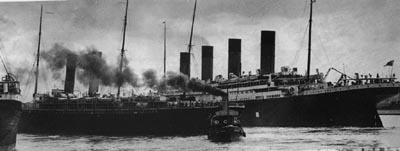
Frederick Fleet sees the Iceberg but it is too late.....
|
|
|
|
|
|
|
|
|
TITANIC'S MAIDEN VOYAGE |
|
The Titanic was finally ready for her departure on April 10 1912. Delays had occurred as a result of the Olympics collision with the HMS Hawke in September 1911 and in February the Olypmic also lost a propeller. The owners wanted to see the Olympic operational before the Titanic. Also that year there was a coal strike. A severe problem for any transatlantic liner because ships like the Titanic would consume over 600 tons of coal a day. To partially solve the problem, coal was taken from other ships like the Adriatic and Oceanic to stock up the coal bunkers for the Titanic's voyage.
At noon on the 10 April 1912 the Titanic set sail from Southampton. Immediately, there was a potential disaster. There was a near collision with the steamer New York. The New York being much smaller than the Titanic was sucked in to her wake as the Titanic giant triple screw propellers rotated. The New York's mooring snapped and was dragged towards the port side of her. This is exactly what happened to her sister ship when she collided with the HMS Hawke. The Titanic sailed to Cherbourg in France and later to Queenstown in Ireland to pick up additional passengers. There were 1320 passengers and 907 crew. The first few days of the voyage were uneventful. Captain Smith steadily increased speed day by day. The ship covered 386 miles on the first day, 519 the second and 546 miles the third. It was reported that Smith would have increased the mileage day by day. The passengers were unaware that one of the coalbunkers had been on fire since departure. Situations like this were common because coal dust which is very flammable, got everywhere, not just in the air but in machinery. As the slightest spark could ignite the whole bunker, coal had to be kept sufficiently damp to prevent fires from starting.
The fire on board the Titanic took until Sunday night to be put out. The ship sailed on.
|

